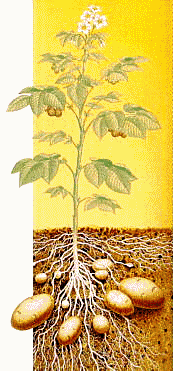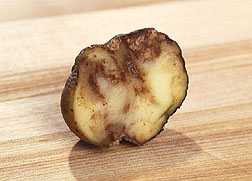The Science of the Famine
and of the Potato
We
may always confront famine as a cultural and political artifact but we
must soon conquer the fungus which caused the Famine before we loose the
Potato. Try spending a day without the potato to learn what this might
be like!
Note- links are not being updated to outside pages. The information is kept here as it may be of assistance.
Potato Crops Worldwide
are threatened by the same
fungus which caused the
Irish Potato Famine
Host weed implicated
Research into the strain of P-infestans that
caused the blight
By Erin Peabody
December 12, 2006
Late blight, the devastating tuber disease that triggered the Irish potato
famine of the mid-1800s, has a new partner in crime.
Scientists with the Agricultural Research Service (ARS) in Orono, Maine,
discovered that Phytophthora infestans—the microorganism behind the
spud-spoiling disease—is seeking refuge in potato fields, holed up in an
alternate host plant: hairy nightshade.
Best known for causing widespread hunger, illness and death in 1840s Ireland,
P. infestans continues to pose a formidable threat to global potato and
tomato production. According to the International Potato Center in Lima, Peru,
the disease costs the world's growers more than $3 billion each year in
fungicides and other control measures.
Modesto Olanya, a plant pathologist at the ARS New England Plant, Soil and
Water Research Laboratory in Orono, learned of the possibility of an alternate
host in 2004 from colleagues at the University of Maine Cooperative Extension in
Presque Isle.
As extension agents in the northern part of the state discovered, hairy
nightshade plants were showing up speckled with suspicious dark and oily spots.
Olanya analyzed the microorganisms on the plants and verified, for the first
time, that hairy nightshade is an alternate host of P. infestans in
Maine.
To make matters worse, hairy nightshade is hardly a wallflower, in terms of
its presence in commercial potato fields in Maine. In a limited survey, Olanya
and University of Maine collaborators found that 55 percent of fields assessed
in the state contained the plant.
According to Olanya, the finding that hairy nightshade is an active host of
P. infestans is problematic in two ways. First, the plant is a secondary
source of the destructive disease. And, it's a weed.
As a result of this ARS research, growers are now learning the importance of
controlling hairy nightshade as part of their overall late blight management
program.
ARS is the chief scientific research agency of the U.S. Department of
Agriculture.
ScienceDaily (Mar. 19, 2004) — In June
2001, North Carolina State University plant pathologist Jean Beagle Ristaino
shocked the scientific world when she published a paper in the journal Nature
that called into question the then-prevailing theories about the strain of
pathogen – and its place of origin – that caused the Irish potato famine in
the 1840s.
Using DNA fingerprinting analysis of 150-year-old leaves – evidence that
had not previously been studied – Ristaino ruled out the longtime prime
suspect behind the famine: the Ib haplotype, or strain, of the late-blight
pathogen Phytophthora infestans, which was presumed to have originated in
Mexico.
Now, in a new study, Ristaino and postdoctoral student Kim May point the
finger at the Ia strain of P. infestans, and trace its probable roots to the
Andes Mountains in South America.
The study will be published in the April 2004 edition of Mycological
Research.
The researchers used DNA sequences from mitochondrial DNA to examine 186
specimens from six different regions of the world dating from as early as 1845
to as late as 1982. The specimens included ones from late-blight epidemics in
Ireland, the United States and continental Europe, and came from collections
housed in England, Ireland and the United States.
About 90 percent of the specimens were confirmed to be infected with P.
infestans, the paper reports. About 86 percent of the specimens – including
those involved in major epidemics in Ireland and other locations around the
globe – were infected with the Ia haplotype of P. infestans. The Ib haplotype
– the one previously presumed to be the culprit behind the Irish potato famine
and other epidemics before Ristaino's groundbreaking 2001 study – was present
only in more modern samples from Central and South America.
Moreover, the researchers found two strains – Ia and IIb – in potato
specimens studied from 1950s Nicaragua. This finding further debunks the
single-strain theory that prevailed before Ristaino's 2001 Nature paper.
Ristaino's lab is currently investigating the center of origin of P.
infestans. She hypothesizes that the pathogen originated in South America and
perhaps made its way to Europe and the United States via exports of potato
seed on steamships. The data to support this hypothesis will be published by
one of Ristaino's graduate students, Luis Gomez, in the next year.
There are four haplotypes of P. infestans – Ia, Ib, IIa and IIb – which is
a fungus-like pathogen that causes severe lesions on leaves of potato and
tomato plants.
The late-blight pathogen led to the Irish potato famine, which killed or
displaced millions of Irish people, and other epidemics across the world. Late
blight continues to wreak havoc as a major potato and tomato killer, which
makes Ristaino's research all the more important.
"If we can understand the strains of P. infestans that are out there now
and see how the pathogen has evolved over time – including how it mutates in
response to fungicides or host resistance – we'll better be able to manage the
disease," Ristaino said.
The research is funded by the National Geographic Society, the USDA
National Research Initiatives Cooperative Grants Program, the North Carolina
State Agricultural Research Service and NC State's International Programs
Office
On Line Guide to Late Blight
Idaho Late
Blight Watch
The
On-Line Late Blight Workshop
Great Papers!
The International
Potato Center on Late Blight
A Page of
Late Blight Resources
(March-April 1998)
Plant
Virus Taxonomy database - The descriptions are derived from the VIDE
(Virus Identification Data Exchange) database, using the DELTA system,
including data on host range; transmission and control; geographical distribution;
physical, chemical and genomic properties; taxonomy and relationships;
and selected literature references. Included are the database accession
numbers (up to Gb[89] and Em[44]) of the genomic sequences of viruses and
of satellite RNAs, with links to the NCBI taxonomy database to facilitate
searches for these and for more current accessions. There are generic-level
summaries of data for viruses that are definitive or tentative members
of genera or 'groups'. There are also tables (with appropriate links) listing
over 1500 host plant species, and their reported (experimental) susceptibilities
to these viruses.
The genetics of Phytophthora infestans
- a June 1996 posting from ProMED (the international epidemic alert list)
US Dept of Agriculture's "Biotechnology
Permits; the Importance of the Potato"
"Purdue researchers genetically engineer blight
resistant potato."
Science
Update page -- A nice narrative of the history of the Famine, with
explanations of some of the potato diseases which caused it.
News
Reports on P. infestans. Potato Blight is still a problem today!
To return to the top of the page click here
The Science of Potatoes
-
Potato
Peels Contain Chemical Residues -- from Cornell Chronicle
-
Potato Modeling Listserver
All about the potato and potato crop computer modeling.
Send your request: sub pot-mod-l and your name (first and last)
to listserv@unl.edu
For example, your email should look like the following (with your name):
[to:] listserv@unl.edu
[body:] sub pot-mod-l Patrick O'Reilly
To contribute submissions, send them to: pot-mod-l@unl.edu
To return to the top of the page click here
Experiments to Do
Learning
to Classify Things by taxonomically sorting potato chips
Potato battery
Stick finger-length pieces of copper and zinc wire one at a time into a
raw potato. If you hold an earphone on the wires, you will hear a distinct
crackling.
The noise is caused by an electric current. The potato and wires
produce an electric current in the same way as a torch battery, but only
a very weak one. The sap of the potato reacts with the metals in a chemical
process and also produces electrical energy. We speak of a galvanic cell
because the Italian doctor Galvani first observed this process in a similar
experiment in 1789.
To return to the top of the page click here
|


